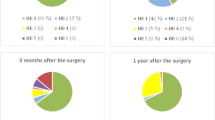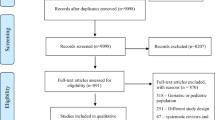Abstract
Objective
Through years, interest in quality of life (QoL) among patients affected by vestibular schwannoma (VS) has increased. The expansion of the indications for endoscopic ear surgery allowed the development of the transcanal transpromontorial surgery (TTS) for VS removal. The objective of the present study was to assess QoL in a cohort of VS patients operated on by translabyrinthine (TL), retrosigmoid (RS) and TTS approach.
Methods
The study was conducted on 111 patients who underwent surgery for VS between January 2017 and January 2020 at two different institutions. Patients fulfilled three questionnaires during follow-up: Glasgow Benefit Inventory, Depression Anxiety Stress Scales-21 and Penn Acoustic Neuroma Quality-Of-Life. The association between sex, age, date of surgery, tumor size, post-operative facial nerve (FN) function and QoL outcomes was assessed.
Results
An overall subjective impairment was demonstrated in all groups. Age, Koos staging and FN functions were associated to distinct QoL outcomes.
Conclusions
QoL decreases in patients surgically treated for VS. The TTS may allow improved scores in many domains, confirming to be a subjectively well-tolerated technique.



Similar content being viewed by others
References
Andresen NS, Gourin CG, Stewart CM et al (2020) Hospital volume and failure to rescue after vestibular schwannoma resection. Laryngoscope 130(5):1287–1293. https://doi.org/10.1002/lary.28174
Gauden A, Weir P, Hawthorne G et al (2011) Systematic review of quality of life in the management of vestibular schwannoma. J Clin Neurosci 18(12):1573–1584. https://doi.org/10.1016/j.jocn.2011.05.009
Carlson ML, Tveiten OV, Driscoll CL et al (2015) Long-term quality of life in patients with vestibular schwannoma: an international multicenter cross-sectional study comparing microsurgery, stereotactic radiosurgery, observation, and nontumor controls. J Neurosurg 122(4):833–842. https://doi.org/10.3171/2014.11.JNS14594
Carlson ML, Van Gompel JJ, Wiet RM et al (2018) A cross-sectional survey of the North American skull base society: current practice patterns of vestibular schwannoma evaluation and management in North America. J Neurol Surg B Skull Base 79(3):289–296. https://doi.org/10.1055/s-0037-1607319 (PMID: 29765827; PMCID: PMC5951692)
Briggs RJ, Fabinyi G, Kaye AH (2000) Current management of acoustic neuromas: review of surgical approaches and outcomes. J Clin Neurosci 7(6):521–526. https://doi.org/10.1054/jocn.2000.0728
Presutti L, Magnaguagno F, Pavesi G et al (2014) Combined endoscopic-microscopic approach for vestibular schwannoma removal: outcomes in a cohort of 81 patients. Acta Otorhinolaryngol Ital 34(6):427–433
Marchioni D, Carner M, Rubini A et al (2016) The fully endoscopic acoustic neuroma surgery. Otolaryngol Clin North Am 49(5):1227–1236. https://doi.org/10.1016/j.otc.2016.05.014
Marchioni D, Carner M, Soloperto D et al (2018) Expanded transcanal transpromontorial approach: a novel surgical technique for cerebellopontine angle vestibular schwannoma removal. Otolaryngol Head Neck Surg 158(4):710–715. https://doi.org/10.1177/0194599818756592
Marchioni D, Soloperto D, Masotto B et al (2018) Transcanal transpromontorial acoustic neuroma surgery: results and facial nerve outcomes. Otol Neurotol 39(2):242–249. https://doi.org/10.1097/MAO.0000000000001658 (PMID: 29227438)
Sacchetto L, Fabbris C, Romito S et al (2020) Facial nerve neurophysiologic assessment in vestibular schwannoma removal with transcanal approach: a pilot clinical study. World Neurosurg 146:e568–e574. https://doi.org/10.1016/j.wneu.2020.10.139 (PMID: 33189920)
Hendry J, Chin A, Swan IR et al (2016) The Glasgow Benefit Inventory: a systematic review of the use and value of an otorhinolaryngological generic patient-recorded outcome measure. Clin Otolaryngol 41(3):259–275. https://doi.org/10.1111/coa.12518
Bottesi G, Ghisi M, Altoè G et al (2015) The Italian version of the Depression Anxiety Stress Scales-21: factor structure and psychometric properties on community and clinical samples. Compr Psychiatry 60:170–181. https://doi.org/10.1016/j.comppsych.2015.04.005
Shaffer BT, Cohen MS, Bigelow DC et al (2010) Validation of a disease-specific quality-of-life instrument for acoustic neuroma: the Penn Acoustic Neuroma Quality-of-Life Scale. Laryngoscope 120(8):1646–1654. https://doi.org/10.1002/lary.20988
Tufarelli D, Meli A, Alesii A et al (2006) Quality of life after acoustic neuroma surgery. Otol Neurotol 27(3):403–409. https://doi.org/10.1097/00129492-200604000-00018
Martin HC, Sethi J, Lang D et al (2001) Patient-assessed outcomes after excision of acoustic neuroma: postoperative symptoms and quality of life. J Neurosurg 94(2):211–216. https://doi.org/10.3171/jns.2001.94.2.0211
Nicoucar K, Momjian S, Vader JP et al (2006) Surgery for large vestibular schwannomas: how patients and surgeons perceive quality of life. J Neurosurg 105(2):205–212. https://doi.org/10.3171/jns.2006.105.2.205
Soulier G, van Leeuwen BM, Putter H et al (2017) Quality of life in 807 patients with vestibular schwannoma: comparing treatment modalities. Otolaryngol Head Neck Surg 157(1):92–98. https://doi.org/10.1177/0194599817695800
Betchen SA, Walsh J, Post KD (2003) Self-assessed quality of life after acoustic neuroma surgery. J Neurosurg 99(5):818–823. https://doi.org/10.3171/jns.2003.99.5.0818
Lee J, Fung K, Lownie SP et al (2007) Assessing impairment and disability of facial paralysis in patients with vestibular schwannoma. Arch Otolaryngol Head Neck Surg 133(1):56–60. https://doi.org/10.1001/archotol.133.1.56
Baumann I, Polligkeit J, Blumenstock G et al (2005) Quality of life after unilateral acoustic neuroma surgery via middle cranial fossa approach. Acta Otolaryngol 125(6):585–591. https://doi.org/10.1080/00016480510026935
Kelleher MO, Fernandes MF, Sim DW et al (2002) Health-related quality of life in patients with skull base tumours. Br J Neurosurg 16(1):16–20. https://doi.org/10.1080/02688690120114183
Lassaletta L, Alfonso C, Del Rio L et al (2006) Impact of facial dysfunction on quality of life after vestibular schwannoma surgery. Ann Otol Rhinol Laryngol 115(9):694–698. https://doi.org/10.1177/000348940611500908
Schwartz MS, Riddle SA, Delashaw JB Jr et al (1998) Quality of life following acoustic neuroma surgery. Neurosurg Focus 5(3):e3
Di Maio S, Akagami R (2009) Prospective comparison of quality of life before and after observation, radiation, or surgery for vestibular schwannomas. J Neurosurg 111(4):855–862. https://doi.org/10.3171/2008.10.JNS081014
Myrseth E, Møller P, Pedersen PH et al (2005) Vestibular schwannomas: clinical results and quality of life after microsurgery or gamma knife radiosurgery. Neurosurgery 56(5):927–935. https://doi.org/10.1055/s-2005-916493
Broomfield SJ, Mandavia AK, Nicholson JS et al (2017) Long-term quality of life following vestibular schwannoma excision via the translabyrinthine approach. Otol Neurotol 38(8):1165–1173. https://doi.org/10.1097/MAO.0000000000001507
Carlson ML, Tveiten ØV, Lund-Johansen M et al (2018) Patient Motivation and Long-Term Satisfaction with Treatment Choice in Vestibular Schwannoma. World Neurosurg 114:e1245–e1252. https://doi.org/10.1016/j.wneu.2018.03.182 (PMID: 29625305)
Pollock BE, Driscoll CL, Foote RL et al (2006) Patient outcomes after vestibular schwannoma management: a prospective comparison of microsurgical resection and stereotactic radiosurgery. Neurosurgery 59(1):77–85. https://doi.org/10.1227/01.NEU.0000219217.14930.14
Myrseth E, Møller P, Pedersen PH et al (2009) Vestibular schwannoma: surgery or gamma knife radiosurgery? A prospective, nonrandomized study. Neurosurgery 64(4):654–663. https://doi.org/10.1227/01.NEU.0000340684.60443.55 (PMID: 19197222)
Andersson G, Ekvall L, Kinnefors A et al (1997) Evaluation of quality of life and symptoms after translabyrinthine acoustic neuroma surgery. Am J Otol 18(4):421–426
Rigby PL, Shah SB, Jackler RK et al (1997) Acoustic neuroma surgery: outcome analysis of patient-perceived disability. Am J Otol 18(4):427–435
Author information
Authors and Affiliations
Contributions
DL, CF, RC, SDG, and FC: data collection; DL and CF: manuscript drafting and statistical analysis; DMo, MAC, DMa, and LP: supervision and manuscript critical revision.
Corresponding author
Ethics declarations
Conflict of interest
The authors have no conflict of interest, funding or financial relationships.
Informed consent
An informed consent has been obtained for any procedure involving the patients described in this article. The manuscript has not been submitted to more than one journal for simultaneous consideration. The manuscript has not been published previously (partly or in full).
Additional information
Publisher's Note
Springer Nature remains neutral with regard to jurisdictional claims in published maps and institutional affiliations.
Rights and permissions
About this article
Cite this article
Lucidi, D., Fabbris, C., Cerullo, R. et al. Quality of life in vestibular schwannoma: a comparison of three surgical techniques. Eur Arch Otorhinolaryngol 279, 1795–1803 (2022). https://doi.org/10.1007/s00405-021-06855-w
Received:
Accepted:
Published:
Issue Date:
DOI: https://doi.org/10.1007/s00405-021-06855-w




